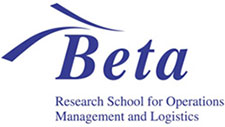Parallel Sessions
Session 10: Food Supply Chain Management – Chair: Rene Haijema
Roel Post (University of Groningen) – The allocation of ownership and control of inventory in a retail supply chain
In the domain of sales forecasting, we develop and test a method that combines the wisdom of planners with the knowledge of the statistical forecasting system. By analyzing how planners adjust statistical forecasts, we identify 1) the strengths and weaknesses of planners and 2) use this in order to reduce the forecasting error. In a large data set (N=68,429), we consistently find that planners perform worse than the system when deciding on the magnitude of upward adjustments, but are surprisingly accurate in predicting whether the statistical forecast should go up or down. These findings are taken into account in a newly developed method in which the planner decides on the direction of the adjustment and the magnitude of the downward adjustment, while an algorithm decides on the magnitude of the upward adjustment. This new forecasting approach reduces the forecasting error on average with 17%. We show that using the strength of the planner, while avoiding its weaknesses, significantly reduces the forecasting error, thus improving inventory levels and profits.
Yousef Ghiami (Vrije Universiteit Amsterdam) – Planning for shortages? Net Present Value analysis for a deteriorating item with partial backlogging
This paper develops inventory models to help answer strategic questions concerning whether planning for shortages offers financial benefits. A production-inventory system producing a deteriorating product in batches at a finite production rate with partial backordering is considered. Customers pay a deposit when placing a backorder. Backordered items receive a discount on the sales price. As lost sales may lead to customers not returning, the demand rate may depend on the fraction of lost sales. We develop a cash-flow based profit maximising Net Present Value (NPV) model without the inventory cost parameters commonly used in this context: unit holding cost, unit backorder cost, unit deterioration cost, and unit lost sales cost. The model finds the optimal inventory policy just like NPV models that discount the traditional parameters but has the advantage of not needing to estimate the value of the traditional parameters. It is shown that in models based on discounting the traditional parameters, the parameters are not exogenously determinable but are non-trivial functions of non-financial endogenous system parameters such as the production rate, annual demand rate, and backorder rate. Extensive numerical experiments illustrate how cash-flow NPV models provide insights into the value of planning for shortages and strategic choices about the design of the production-inventory system. It also provides insight into the classical problem of how to interpret unit backorder cost and unit lost sales cost. The study indicates that these insights cannot be reliably obtained from NPV models based on discounting unit backorder costs and unit lost sales costs.
Argyris Kanellopoulos (Wageningen University & Research) – Sugar beet biobased supply chains
The abolishment of the sugar beet quota policy is expected to affect the demand and supply of white sugar at EU level. Lower price of sugar will have a cascading effect on the supply of sugar beet and consequently the viability of the chain as a whole. To remain competitive, the European sugar industry will have to adapt to these new developments. Recently, alternative biomass-based processing technologies have become available. These technologies require small scale facilities that can reduce transportation costs substantially and enable production of biomass-based products like bioethanol and biogas from crop residues. The potential of alternative technologies to mitigate the negative impacts of policy changes have not been evaluated yet at chain level. The objective of this research is to design competitive biomass-based sugar supply chains that benefit from alternative technologies. We develop a multi-objective Mixed Integer Linear Programming model to optimize decision making at individual links of the sugar supply chain i.e. beet production and processing. The model was applied to re-design the sugar supply chain in the Netherlands. We found that investment on small scale bio refining facilities that enable production of bio-ethanol and biogas increases profitability of the chain as a whole. However, to maintain supply of sugar beet, additional profits at processing level should be transferred to farms in the form of price support for sugar beet production.
